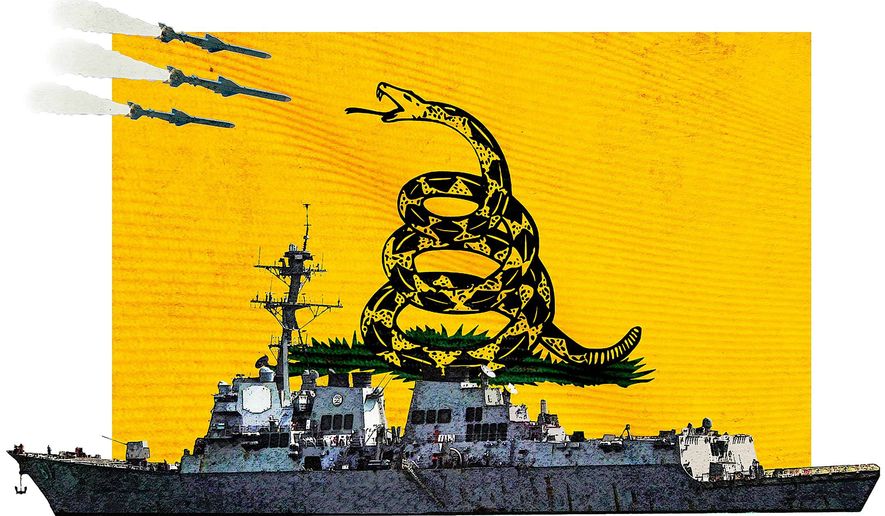OPINION:
The recent missile attacks attributed to Yemeni Houthi rebels, with assistance from the Iranian Revolutionary Guard Corps (IRGC) and Hezbollah, demonstrate Iran’s classic use of proxies to promote its political agenda. The Houthi rebels denied any involvement in the missile attacks. However, they certainly were not fired by camel herders. The Houthis never would have launched an attack on the U.S. Navy without being ordered to do so by their Iranian sponsors. To think otherwise would be delusional.
Iran has the failed to honor the Obama administration’s nuclear weapons agreement. There is actually no agreement, since nothing has been signed. With Russia’s support in Syria, Iran clearly feels emboldened to challenge the United States directly. And with the $150 billion sanctions relief windfall, plus planeloads of hard cash totaling more than $33 billion, Iran can easily expand its role as the leading state sponsor of terrorism, which is what we are witnessing in Yemen. The Iranian use of proxies has cost thousands of American lives, but, fortunately, this time they failed.
Clearly, Iran wants to be able to control the strategic Bab al Mandab Strait, which would give it de facto control of the Suez Canal. More than 10 percent of the world’s maritime shipping passes through that strait on a daily basis. Such control, when combined with control of the Strait of Hormuz, would give Iran control of all Arab oil shipments as well as all Israeli shipping emanating to and from the port of Eilat in the Red Sea. Iran would also like to see our 71-year alliance with Saudi Arabia terminated.
With the help of the IRGC and the Iranian proxy terrorist group Hezbollah, two radar sites were recently constructed outside of Yemen’s two principal Red Sea ports, Mokha and Hudaydah, which are currently under the control of the Houthi rebels. These sites, according to various reports, were operated by IRGC and Hezbollah radar and missile teams. The missiles fired were an upgraded version of the Chinese C-802 anti-ship missile. It should be remembered that on July 14, 2006, Hezbollah successfully fired a C-802 missile against the Israeli missile ship INS Hanit, inflicting heavy damage.
Despite Iran’s assurance about not providing weapons, the Houthis received a delivery the week prior to the missile attacks, the largest shipment of Iranian weapons to date. Obviously, this shipment, apparently undetected by our intelligence resources, included Scud D surface-to-surface missiles with a range of 800 kilometers as well as the upgraded Chinese C-802 anti-ship missiles. The Scuds went to the northern border to be used against Saudi Arabia, and the C-802 anti-ship missiles went to the Houthi’s Ansar Allah faction, which is under the direct control of the IRGC.
The same day missiles were fired against the USS Mason, Oct. 9, the Houthis, with the assistance of the IRGC, fired Scud-D missiles at the Saudi town of Ta’if, which is 700 kilometers from the Yemeni border — but, more importantly, only 70 kilometers from the holy city of Mecca. The message to the Saudis was clear. Iran intends to challenge the Saudis’ control of Islam’s most holy sites.
The Red Sea is a very narrow strategic body of water. It is only 62 kilometers from the Saudi coast to Africa. All shipping can be threatened and easily attacked with the current inventory of missiles transferred to Yemen.
The Houthis have also landed and taken control of Perim Island in the mouth of the Bab al Mandab Straits. Since the main maritime route is only 20 kilometers wide at this point, it serves as a natural choke point and a threat to all shipping as long as it remains under Houthi-Iranian control.
How did we get involved in this classic Sunni-Shia sectarian war? Very briefly, in late 2014, Shia Houthi rebel forces captured the capital city of Sana’a. The Houthis, backed by Iran, are fighting against the internationally recognized government of Yemen’s Sunni president, Abdrabbuh Mansour Hadi. In March 2015, the Saudis led a campaign to overthrow the Houthi rebels. President Obama, in an attempt to get Saudi Arabia’s support for his nuclear weapons agreement with Iran, agreed to support the Saudi effort. We proceeded to provide limited intelligence, in-flight refueling, command and control guidance and some weapons.
The missile attack on our forces in the vicinity of the Bab al Mandab Straits is another manifestation of Iran’s contempt for America and disregard for international norms. Further, with little to fear from an Obama administration response, they clearly have been emboldened to further their hegemonic objectives by challenging our forces directly. While the Houthi’s missile attack on the United Arab Emirate’s HSV-2 Swift Catamaran vessel was successful on Oct. 1, their attack on the USS Mason was, fortunately, a failure. While it took us four days to respond, the USS Nitze’s tomahawk missile strikes destroyed the three Iranian radar sites, which eliminated the immediate threat to shipping in the area.
This was a minimum response — a tit for tat — which will most likely invite more attacks, since C-802 missiles can be fired without radar. When an enemy attacks one of our U.S. Navy ships, our response must be overwhelming. =We should have destroyed not only the radar sites but also any missile-launching sites and any associated ammo storage sites. Any known Iranian installations should have been destroyed. Electrical utility grids that provide power to support Houthi rebels and Iranian forces in the two areas should also be destroyed. The Houthi installation on Perim Island should be eliminated. The message must be clear: “Don’t tread on me.”
• James A. Lyons, a U.S. Navy retired admiral, was commander-in-chief of the U.S. Pacific Fleet and senior U.S. military representative to the United Nations.




Please read our comment policy before commenting.